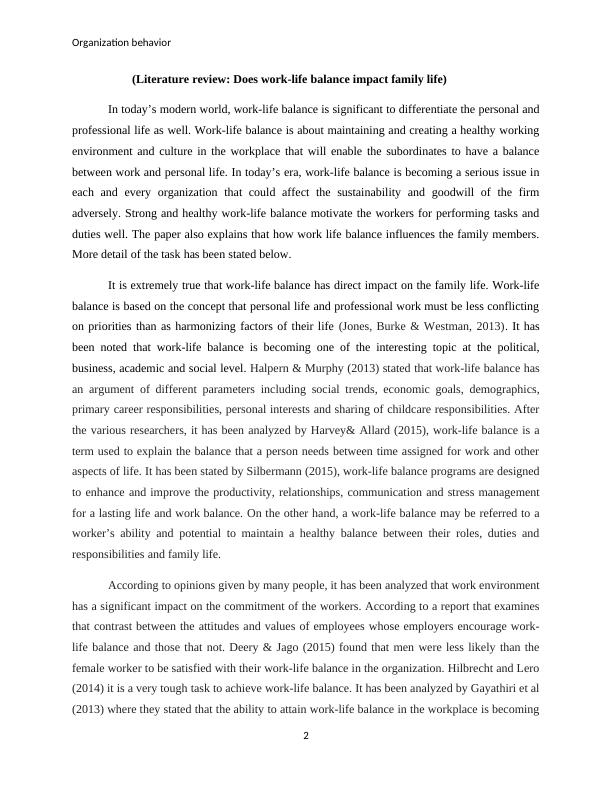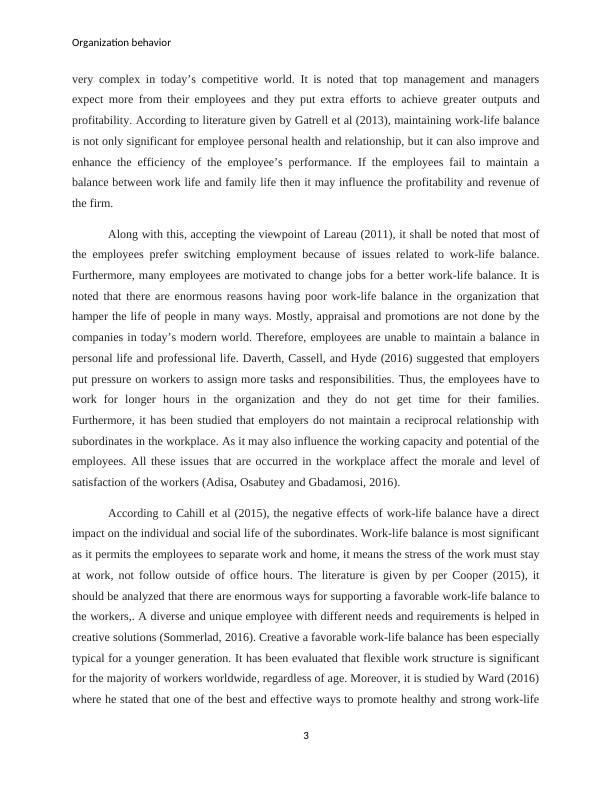Organizational Behavior - Work Life Balance
Added on 2021-05-31
8 Pages2856 Words167 Views
Running head: Organization behavior Organization behavior

Organization behavior (Literature review: Does work-life balance impact family life)In today’s modern world, work-life balance is significant to differentiate the personal andprofessional life as well. Work-life balance is about maintaining and creating a healthy workingenvironment and culture in the workplace that will enable the subordinates to have a balancebetween work and personal life. In today’s era, work-life balance is becoming a serious issue ineach and every organization that could affect the sustainability and goodwill of the firmadversely. Strong and healthy work-life balance motivate the workers for performing tasks andduties well. The paper also explains that how work life balance influences the family members.More detail of the task has been stated below. It is extremely true that work-life balance has direct impact on the family life. Work-lifebalance is based on the concept that personal life and professional work must be less conflictingon priorities than as harmonizing factors of their life (Jones, Burke & Westman, 2013). It hasbeen noted that work-life balance is becoming one of the interesting topic at the political,business, academic and social level. Halpern & Murphy (2013) stated that work-life balance hasan argument of different parameters including social trends, economic goals, demographics,primary career responsibilities, personal interests and sharing of childcare responsibilities. Afterthe various researchers, it has been analyzed by Harvey& Allard (2015), work-life balance is aterm used to explain the balance that a person needs between time assigned for work and otheraspects of life. It has been stated by Silbermann (2015), work-life balance programs are designedto enhance and improve the productivity, relationships, communication and stress managementfor a lasting life and work balance. On the other hand, a work-life balance may be referred to aworker’s ability and potential to maintain a healthy balance between their roles, duties andresponsibilities and family life. According to opinions given by many people, it has been analyzed that work environmenthas a significant impact on the commitment of the workers. According to a report that examinesthat contrast between the attitudes and values of employees whose employers encourage work-life balance and those that not. Deery & Jago (2015) found that men were less likely than thefemale worker to be satisfied with their work-life balance in the organization. Hilbrecht and Lero(2014) it is a very tough task to achieve work-life balance. It has been analyzed by Gayathiri et al(2013) where they stated that the ability to attain work-life balance in the workplace is becoming2

Organization behavior very complex in today’s competitive world. It is noted that top management and managersexpect more from their employees and they put extra efforts to achieve greater outputs andprofitability. According to literature given by Gatrell et al (2013), maintaining work-life balanceis not only significant for employee personal health and relationship, but it can also improve andenhance the efficiency of the employee’s performance. If the employees fail to maintain abalance between work life and family life then it may influence the profitability and revenue ofthe firm. Along with this, accepting the viewpoint of Lareau (2011), it shall be noted that most ofthe employees prefer switching employment because of issues related to work-life balance.Furthermore, many employees are motivated to change jobs for a better work-life balance. It isnoted that there are enormous reasons having poor work-life balance in the organization thathamper the life of people in many ways. Mostly, appraisal and promotions are not done by thecompanies in today’s modern world. Therefore, employees are unable to maintain a balance inpersonal life and professional life. Daverth, Cassell, and Hyde (2016) suggested that employersput pressure on workers to assign more tasks and responsibilities. Thus, the employees have towork for longer hours in the organization and they do not get time for their families.Furthermore, it has been studied that employers do not maintain a reciprocal relationship withsubordinates in the workplace. As it may also influence the working capacity and potential of theemployees. All these issues that are occurred in the workplace affect the morale and level ofsatisfaction of the workers (Adisa, Osabutey and Gbadamosi, 2016). According to Cahill et al (2015), the negative effects of work-life balance have a directimpact on the individual and social life of the subordinates. Work-life balance is most significantas it permits the employees to separate work and home, it means the stress of the work must stayat work, not follow outside of office hours. The literature is given by per Cooper (2015), itshould be analyzed that there are enormous ways for supporting a favorable work-life balance tothe workers,. A diverse and unique employee with different needs and requirements is helped increative solutions (Sommerlad, 2016). Creative a favorable work-life balance has been especiallytypical for a younger generation. It has been evaluated that flexible work structure is significantfor the majority of workers worldwide, regardless of age. Moreover, it is studied by Ward (2016)where he stated that one of the best and effective ways to promote healthy and strong work-life3

End of preview
Want to access all the pages? Upload your documents or become a member.
Related Documents
Organizational Behavior and Work-Life Balancelg...
|6
|1780
|331
Work Life Balance and its Impact on Individuals, Leaders, and Organizationslg...
|4
|669
|32
The Organisational Consequences of Work-Lifelg...
|8
|2993
|341
Connecting strategies with HRM: Literature review on organizational culturelg...
|5
|1298
|134
Literature Review on Employee Engagementlg...
|8
|2525
|323
Organizational Consequences of Work-Life Balancelg...
|7
|2074
|258
